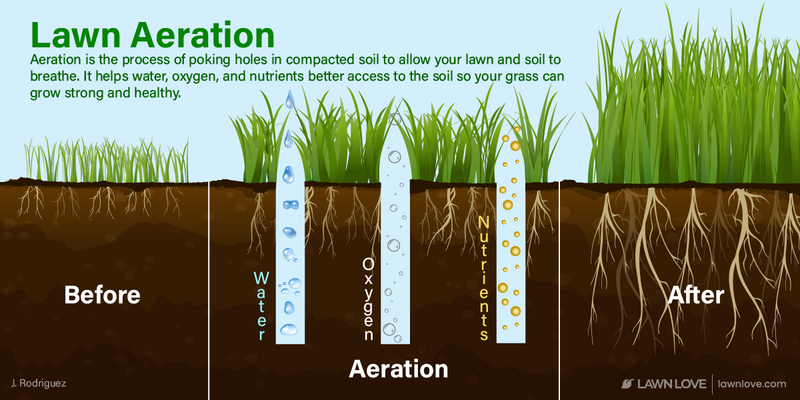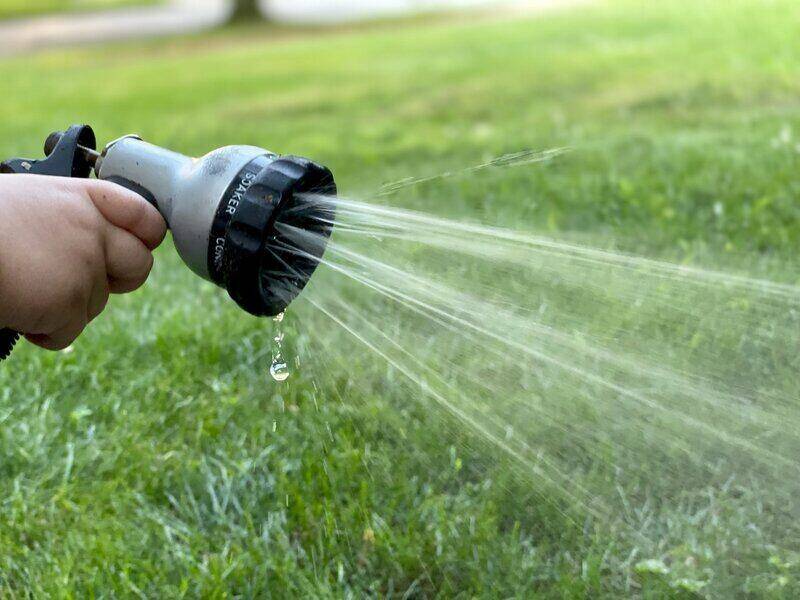
An Allentown autumn appeals to the sense of taste, smell and sight. It’s that transitional time of year — a switch to cool temperatures, more backyard fires, the seasonal tastes of apple pie and pumpkin spice, and the start to football season. But, then you glance outside your window and realize those gorgeous-colored leaves now blanket your lawn. If you need a few fall lawn care tips to manage your Allentown lawn, we’re here to help.
Here’s 11 fall lawn care tips for your cool-season Allentown grass:
- Rake hardy
- Dethatch
- Aerate
- Overseed
- Fertilize, if necessary, to stimulate growth
- Control weeds
- Mow until it doesn’t grow
- Water wisely
- Winterize your sprinkler system
- Clean your lawn mower and other garden equipment
- Prep and prune

1. Rake hardy
Fall and raking leaves seem to go hand-in-hand. The trees “weep” leaves at a frantic pace. You’ll need to stay on top of it by raking every few days. Not only are those mounds of leaves unsightly, but they also can:
- Block sunlight
- Result in disease and decay
- Ruin your lawn
- Beckson uninvited pests
If you grow weary of wielding a rake, switch to a leaf blower. Don’t have one in your shed? Your local nursery would be happy to rent you one. They come in a variety of models and prices. You just might find one to purchase or rent that suits your budget (and saves your back!).
Check out the differences in blowers:
Gas Blower
- Expensive
- Powerful
- Heavy
- Noisy
- Releases smoke
Corded:
- Reasonably priced
- Lightweight
- Needs to be attached to a power outlet
- Doesn’t release smoke
Battery-powered:
- Restricted by battery strength
- Reasonably priced
Gas and battery operated blowers blow fast and efficiently. However, gas blowers tend to be quite noisy. (Check with the Noise Pollution Clearinghouse for an emissions and usage guideline for your area.) Gas blowers might be banned completely, and blowing, in general, could be limited to certain times.
Pro Tip: When selecting a blower, bear in mind the weight and size. You’ll want to be able to comfortably use it for more than 15 minutes.
After you’ve gathered the leaves, it’s an opportune time to start a compost pile (or add to an existing one). Leaves are loaded with carbon, a necessary ingredient for photosynthesis, and, hence, your lawn’s health.

2. Dethatch
Thatch is a mix of dead stems, leaves, and roots that build up between the turf and soil. That built-up layer acts either as good mulch or is detrimental to your lawn.
If thatch is less than a ½-inch thick, it:
- Enables the soil to retain moisture
- Insulates the lawn against extremes in soil temperature
Thatch over 1/2 inch can:
- Block the flow of air, water, and fertilizer
- Interfere with the efficiency of herbicides and insecticides
- Provide a home for unwanted pests and diseases
A simple test to determine if you have thatch:
- Survey your lawn for brown spots
- Measure the spongy layer between the surface and grass
- If that layer is greater than ¾ inch, you have a thatch problem
Why dethatch cool-season grass in the fall?
Early fall dethatching provides a quicker recovery for your lawn as the grass is in an active growing cycle.
Ways to dethatch:
- Manual rake works best in small areas
- Power rake, dethatcher, or verticutter are more efficient for larger areas
If dethatching sounds a bit overwhelming, or if you don’t have the proper equipment, call in a professional lawn care service to get the job done right.

3. Aerate
Aerating cool-season grass in the fall allows the turf to recover during this time of active growth. Spring is the second best time of the year to aerate.
What is aeration? Aeration is a process of creating holes in the soil. This task is designed to relieve soil compaction and allow water, oxygen, and nutrients to penetrate the roots.
If any of the following conditions exist, you need to consider aeration:
- Compacted soil
- Heavy foot traffic or equipment defaced your lawn
- Heavy, clay soil
What is compacted soil? This occurs when soil particles, firmly packed or pressed together result in dense soil that doesn’t allow air, water, or essential nutrients to enter.
- Reducing thatch
- Healthy grass growth
- Stymying weeds
- Nutrients penetrating the soil
- Breaking up compacted soil
- Repairing damage from vehicles, heavy machinery, or constant foot traffic
The type of tool or equipment you will use depends on the size of your lawn and its damage:
- Rake
- Spike aerator
- Core aerator
A rake and spike aerators work best on smaller lawns. On the other hand, core aerators are great for bigger lawns and can be rented from garden equipment centers or nurseries. However, the operator must possess experience, skill and strength. This task might best be performed by a professional.

4. Overseed
Summer fun with family and friends — barbecues, horseshoe games, bocce, frisbee with the kids and pets — all take a toll on your lawn. Extensive foot traffic results in bare spots which, subsequently, require overseeding.
What is overseeding? Overseeding is rejuvenating your lawn by spreading and planting grass seed over the surface. Your existing lawn will not be disturbed but, at the same time, you’ll be enhancing the color, health, and thickness.
Early fall’s daytime mild temperatures and cool evenings provide just the right atmosphere for seeds to germinate. Also, the soil moisture proves to be appropriate in the fall. You can overseed in the spring as your second choice but get to it early before that sun roasts your soil.
Overseeding steps:
- Mow (leave about 1 ½ inch to 2 inch grass blades)
- Dethatch
- Aerate
- Add compost
- Spread seed
- Rake to mix in seed
- Fertilize
- Apply a thin layer of mulch or straw
- Water every day for about 3 weeks

5. Fertilize, if necessary, to stimulate growth
Before your grass settles in for a winter, add fertilizer to energize the lawn.The best time to fertilize your cool-season grass is October through early November.
Here’s why you should fertilize:
- Encourages spring and summer growth
- Promotes density
- Discourages weeds
- Enhances the color
- Preps the lawn for winter
- Reduces water runoff
However, before you grab that fertilizer bag, you must perform a soil test. Testing is essential to determine the health of the soil and ascertain the exact ratio of nitrogen (N), phosphorus (P), and potassium (K). This is called the N-P-K ratio. For example, a fertilizer package stating 30-10-30 contains 30% nitrogen, 10% phosphorus, and 30% potassium.
How to conduct a soil test:
- Use a garden shovel or trowel
- Thoroughly clean your digging tool
- Dig approximately 6 inches
- Collect samples from different areas around your yard
- Collect about 2 cups
- Place in a plastic container and mix well
- Do not collect wet soil (wet soil can give a false reading)
Your soil sample can be taken or sent to the Lehigh Valley extension office. Alternatively, you can purchase an at-home soil test kit from them or a nursery.

6. Weed control
In the Lehigh Valley you might come across one or more of the the following weeds come fall:
- Dandelions
- Musk thistle
- Greater celandine
- Henbit
- Shepherd’s purse
- Moneywort
Weeds, an undesirable nuisance, need to be tackled in the fall with a pre-emergent herbicide to prevent a spring outburst. However, if those invaders are still persistently emerging in the fall (and that’s not all that unusual), knock them dead with a post-emergent herbicide.
Weeds need to be controlled for the following reasons:
- Take up garden space
- Stymie the good plants from thriving
- Might provide housing for unwanted insects
- Rob water and nutrients from desirable plants
Of course, there’s always the tried and true method of pulling weeds by hand. You might have some luck applying hand-to-hand combat with a dandelion, but you need to pull the entire root. In general, applying an herbicide requires less labor and is more effective.

7. Mow until it doesn’t grow
Cool-season grasses continue to require mowing in the fall, but not as often. Mow about every four to seven days.
As the temperature cools down, your grass will grow at a slower rate. Cool-season grasses should be kept to about 2 to 2 ½ inches high in both spring and fall. That last mow, before the frost, shouldn’t be higher than 2 inches. You don’t want to be higher as long and matted grass becomes susceptible to diseases, such as snow mold.
Adhere to the one-third rule of mowing. Do not cut more than one-third of your grass’s total height. Consider the following height guidelines for cool-season grasses:
| Kentucky bluegrass | 1.25-1.5 inches |
| Fine fescue | 1.5-2.5 inches |
| Tall fescue | 1.5-3 inches |
| Perennial ryegrass | 1.5-2.5 inches |

8. Water wisdom
Cool-season grasses in Allentown continue to grow in autumn. A well-hydrated lawn results in a healthy root system and greener pastures come spring. Your lawn’s health depends on deep, but infrequent watering. Continue to do so until the first freeze.
Your lawn requires 1 to 1 ½ inches of water per week. If rainfall isn’t supplying enough water, you will need to provide the extra moisture.
How to properly water:
- Set your irrigation system to run in the early morning, before 10 a.m.
- Early morning sun will assist in drying off the grass
- Watering at this time reduces the possibility of disease
- Do not water later in the day; sun will evaporate the water
How to measure the amount of water produced via your irrigation system:
- Place small cans or rain gauges around your lawn
- Cans should be placed close, mid range and far away from the sprinklers
- Let sprinklers run for 15 minutes
- Turn off sprinkler
- Measure depth of water in the cans
- Calculate the average output

9. Winterize your sprinkler system
It’s imperative to shut down your sprinkler system completely before both you and your lawn get settled in for the winter. Excess water left in the system can freeze and cause cracked pipes, broken sprinkler heads and all sorts of havoc. Your system could burst and be totally destroyed!
There are three ways to winterize your sprinkler: manual drain, automatic drain, and the blow-out method. To determine the correct method for you depends on your irrigation system and how it operates.
Automatic drain:
- Turn off water
- Turn on sprinkler
- Drain water
- Loosen the solenoid on every valve
- Let excess water drain out
- Tighten solenoid
Manual drain:
- Shut down water supply to your system
- Set backflow preventer to 45 degrees
- Drain lines
- Turn on faucet close to backflow and drain again
- Drain water in manifold and keep open for the winter
- Return to main water supply
- Turn on and completely drain water
Blow-out method:
This method requires skill, is time-consuming and can be dangerous. You run the risk of damaging the entire system, and yourself. We highly recommend you call a professional.

10. Clean your lawn mower and other garden equipment
Before Jack Frost makes an appearance, all gardening equipment needs to be spotless before storage. Sanitize with bleach to remove all soil; oil and air dry.
Gas and battery-powered mowers:
- Wipe off any moisture and debris
- Disconnect spark plug and drain gas on the gas model
- Remove battery from battery-powered mower
- Store all models in a dry place such as a garage or shed
Leaf blowers:
- Replace and/or clean filter
- Disconnect spark plug and possibly replace
- Drain excess fuel
- Check hose for cracks
- If your blower has a bag, empty it
Weed wackers:
- Clean with soapy water
- Remove and clean and/or replace filter
- Disconnect and possibly replace spark plug
- Drain excess fuel
- Clean carburetor
Pro Tip: Before winter storage, all manual, electrical and battery operated equipment should be cleaned and properly maintained.
When in doubt, check your manual. If you can’t find it, search the company’s website for further information.
Also, don’t forget about those terra cotta pots, fountains and other ornamental items that could freeze in the winter. GIven their porous nature, they absorb moisture, expand and crack.
Empty the pots, clean, and shelter, upside down in the garage or shed. If the object is too large to move or you don’t have room in your garage, cover with a waterproof tarp. If at all possible, prop them up, so as not to be directly on the ground.

11. Prep and prune
Survey your garden and lawn:
- Trim hanging branches
- Remove weeds and dead flowers
- Rework plant beds; divide plants so they aren’t in competition for space come spring
- Insulate with mulch to regulate soil temperature
- Plant early spring bulbs, such as daffodils and tulips
Mulch tips:
- Spread a 2-inch layer in your flower beds
- Do not mulch directly against the tree trunk; leave a 6-inch radius from the base
- Mulch regulates soil temperatures and retails moisture
Don’t fall back on your lawn care
Nestling by a fire (indoors or outdoors), picking apples, carving pumpkins, and watching football are appealing fall activities. Lawn care tasks might be the furthest thing from your mind.
However, this season is just when your lawn requires some TLC. Follow our 10 steps to help your lawn transition through the winter for a glorious, lush, green Allentown spring.
If you’d like to gift yourself some TLC, let Lawn Love’s Allentown lawn care pros take on some of the tasks.
Main photo credit: Magda Ehlers | Pexels